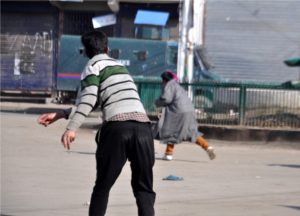
by Asma Khalid 12/2/2018
Ever since the creation of Pakistan and the ensuing problem of the accession of the Princely state of Jammu and Kashmir, the Kashmiri people have been suffering under the unjust Indian occupation. Despite India’s military and political maneuvers in the occupied Kashmir, the majority of the local population has been seeking after their entitlement to plebiscite and has been firmly communicating the same through every available means at local and international forums. With the issue of Kashmir being on the agenda of the United Nation (UN) for decades, the insignificant response of the world community, the insularity of international organizations and India’s consistent avoidance from the dialogue, the indigenous and localized movement in Kashmir seems to have fallen into a stalemate internationally.
UN adopted several resolutions on the Kashmir conflict calling for a plebiscite in Kashmir under the umbrella of the UN. It is significant to mention that UNSC, resolutions recognized the right of the people of the state of Jammu and Kashmir to decide their future through a process of self-determination where they have the right to exercise their will through a transparent and free plebiscite under the supervision of the United Nation’s observers. India’s government officials and representatives in the UN agreed to hold a plebiscite for the final solution. Later, India followed the delaying tactics with regards to holding the plebiscite, and now India has stepped back from its initial commitment that it gave to the people of Jammu and Kashmir and the international community at United Nations platform. India is pursuing the policy of violence and brutal suppression of Kashmiri people by using massive scale violence as a tool to force people to accept India’s illegal occupation of the state. According to various reports, five Kashmiri youth were killed by Indian security forces in Ganawpora area of Shopian District on February 2, 2018. Human security in Indian held Kashmir is seriously threatened by Indian forces. The basic right to live a prosperous life is being challenged by India; therefore killing of innocent Kashmiri people underscores the ongoing genocide in Kashmir.
Indian Defence Minister George Fernandes openly threatened Pakistan regarding AJK and GB, claiming these areas as integral part of India along with IOK. Unfortunately, the distrust further increased after high profile ceasefire violations were reported comprising a massive exchange of fire at the LOC between India and Pakistan. Frequent border clashes between India-Pakistan have further collapsed the peace talks between the two while several troops and civilians of both states have been killed during the heavy exchange of fire.
Notwithstanding, currently there is a sheer stalemate between India and Pakistan regarding negotiations and the whole international community is maintaining the silence thus allowing the status quo to prevail. The criminal silence of the United Nations and the international community towards the human rights violations and sufferings of the people of Jammu and Kashmir is humanity matter of shame for the whole world. Though Indian brutal repression and deadly silence of international community have been counterproductive and the entire Kashmir has been united under the call for the right of self-determination. It is noteworthy that Kashmiris don’t have a sovereign window but Pakistan. Pakistanis are much successful in the context of Kashmir for they didn’t allow the issue to fade through diplomatic and political strategy.
Kashmir issue acquires a growing significance when in the backdrop of nuclearization of South Asia, a handful of liberals and Indian lobby overemphasize the issue by terming it as a possible “nuclear flashpoint” in South Asia. It is significant to note that the elements of strategic stability are gaining strength in the South Asian region. Though in the light of atomic weapons, the perils of an armed conflict are more serious and alarming, but strategic stability and deterrence equilibrium have played a key role in reducing the chances of an armed conflict during the times of heightened tensions, e.g., parliamentary attacks of 2001-2002, Mumbai terrorist attacks of 2008, violations of cease-fire agreement and Indian fabricated claims of the surgical strikes.
Another dimension of the issue is that India is following the policy of presenting Kashmiri people as terrorists and Pakistan as a terrorist country. Nonetheless, the right of self-determination must not be coupled with terrorism. Pakistan should not withdraw from its principled stance of the right of Kashmiris for self-determination. So the question arises that in the renewed circumstances what should be Pakistan’s course of action about Indian Occupied Jammu and Kashmir in the light of new developments?
First, the strategy to resolve the Kashmir issue is through “self-determination.” Second, Pakistan should revisit its strategy as the world does not run on the fair play. Third, it is imperative for Pakistan to support the Kashmir cause on all forums as Kashmiris require more support from Pakistan. Fourth, the international community should break its silence and must avoid its selective condemnation. Fifth, along with the political dimension to the Kashmir conflict there is a strong need to work on the economic dimension of the issue for the development and prosperity of Kashmiri people.
To conclude, there is no denying the fact that although some threats and challenges are attached with the Kashmir conflict, the goal of security and stability in the region largely depends upon the resolution of Kashmir dispute by the wishes of the Kashmiri people.
The writer is currently working as Research Associate at Strategic Vision Institute and can be reached
